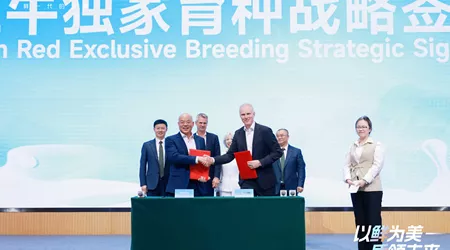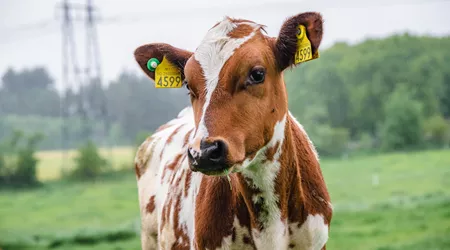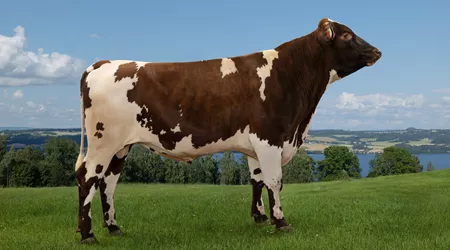By: Trygve R. Solberg, Director of Business Development for GENO.
Geno continues to put a strong focus on improving the genetic performance of its Norwegian Red population, and by keeping a balanced breeding goal for more than 50 years, the Norwegian Red breed has dominated the global market with excellent fertility, health, and production.
Following the result from the August 2021 Proof Run, one Norwegian Red bull worthy of the spotlight is NR12139 Aland-PP. An exceptional sire with a well-balanced trait profile, Aland-PP transmits excellent daughter fertility, feet & legs, and calving ease, in addition to very good daughter fat and protein production. Sired by NR11942 Agholt, his maternal grandsire is NR11191 Vamman, and he is representing a solid Norwegian Red pedigree.
Homozygous polled with A2/A2 for beta-casein and BB for kappa casein
With many great characteristics and trait profiles, Aland-PP is particularly unique and is worth the attention. He is homozygous polled, is A2/A2 for beta-casein, and BB for kappa casein. A rare combination for a bull of his kind, his unique genetics and characteristics are making him in high demand and are highly desirable for many farmers in the global market.
Cow milk contains approximately 3.5% protein, and the caseins are counting for about 80% of the protein content, whereas the rest is whey proteins. The casein is again divided into different types or classes, named αS1, αS2, beta-casein (β-casein), and kappa-casein (κ-casein). It is eminent that variants of these proteins affect milk quality, e.g., for cheese production. The β-casein has two main variants of A1 and A2, the frequency of the A2 variant in the Norwegian Red population is remarkably high (80%).
Aland-PP is homozygous for the A2 variant, which means that he will be transmitting this valuable variant to his offspring. The kappa casein (κ-casein) is also existing in two variants, A and B. The B variant and the homozygous BB genotype are associated with increased milk protein and casein content, and better cheese yield. Relative to protein content and cheese production, BB is the most coveted genotype, AB is intermediate, and AA is the least desirable. Norwegian Red’s Aland-PP is homozygous for the favorable B variant which will also be transmitted to his offspring.
Polled genetics in the Norwegian Red population
A significant number of Norwegian Red bulls are polled, and some are homozygous polled. All offspring of homozygous polled bulls will be born polled. Polled genetics are important to dairy farmers who are looking to avoid dehorning their calves. The dehorning process can cause stress in calves that can lead to poor health. Aland-PP is homozygous for the polled gene and polled is very important from an animal welfare point of view.
NR12139 Aland-PP is currently one of the very few Red bulls with this unique genotype, making him a very appealing Norwegian Red sire and in high demand globally.
Go to Norwegian Red Sire Catalogue for full information on NR12139 Aland-PP.



